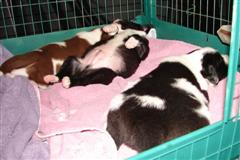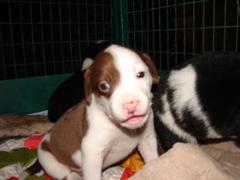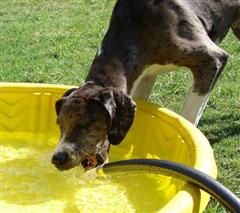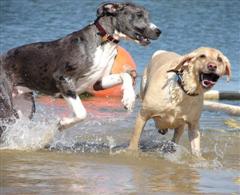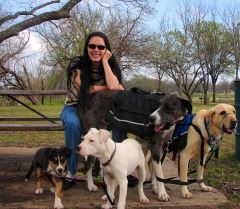|
Until your pup has had her full series of shots (usually finished at 16 weeks) she should not walk where unvaccinated dogs might wander. But that doesn't mean that you shouldn't take her out with you. A crate keeps her safe in the car (and the car's interior safe from her) and her own collar and leash keep her safe out of the car.
Take her to visit friends, particularly those with vaccinated dogs, and let her meet and play with other dogs. When you have company, put her leash on her and get her to sit so newcomers can pet her. Don't allow her to jump up on people. What is appealing at twenty pounds can be appalling at one hundred twenty!
In the house, get her used to normal noises - vacuum, dishwasher, dropped pots - and if your house is an unusually quiet one, you should look for occasions to make noises. If you don't have children in your house, find some neighbor children and invite them in to play with the pup. Use the time to also teach the children about the correct way to approach a strange dog. Your pup needs to learn that small children move differently than adults. If you don't have cats, visit friends who do. Keep the pup on a leash around the cats; discourage any chasing on the pup's part, or aggression by the cats.
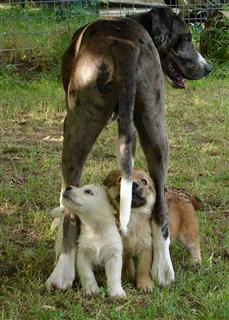
|
|
If you have stairs, teach her to walk safely both up and down them; don't let her jump down. If you don't have stairs, visit friends who do and practice on them. While she is small, it is probably best to avoid the kind open in the back; they are visually confusing to a pup that is at their level. Know any place that allows dogs that also has an elevator? Make some casual trips up and down. Forget escalators - they aren't safe for dogs.
After the vaccinations are complete, enroll your pup in training classes - puppy kindergarten now, or obedience starting at six months. Encourage your pup to be friendly with everyone at the class, canine and human. Protect her from possible aggression by larger or older dogs, but let her play with friendly dogs. Praise her for allowing other people to look in her mouth and handle her ears and feet. Teach her to stand still for petting and grooming. If your vet or feed store has a floor scale, take her for a visit every couple of weeks so she gets used to the feeling of the scale moving under her. (Helps you know how her growth is progressing as well!)
Don't worry that all of this socializing will make her "too friendly" to be protective as an adult. To the contrary, it will teach her what normal human and canine behaviors are like, and allow her to distinguish, and be wary of, the abnormal.
About timid Dogs - the so-called Fear-Biters
Most Timidity Is Preventable
When it comes to raising a confident well-adjusted puppy, an ounce of prevention is certainly worth a pound of cure. By socializing one's puppy early on with a variety of new and unfamiliar people (including calm and gentle children), on a regular and ongoing basis (for at least the first two years of the dog's life), you can help prevent serious behavioral problems such as shyness, timidity, and aggression from developing as the puppy matures. Once a puppy has all of his puppy shots (usually by 16 weeks of age), he should also be socialized with other friendly dogs, and acclimated to new environments beyond the owner's home and property, by being taken for regular daily walks on a leash.
Puppies raised in country and suburban environments should be gradually acclimated to city noises such as traffic noise, crowds of people and other everyday life scenerios early on. A weekly visit into town (beginning when the puppy is around 8 to 10 weeks of age) can be very helpful in preventing environmental phobias. In order to prevent exposure to disease, puppies with fewer than 3 or 4 series of vaccinations, should avoid contact with unfamiliar dogs, and be carried (in a Sherpa Bag, Snuggly or crate) to avoid contact with the sidewalk (or any other public areas where other dogs may frequent).
What To Do If Timidity Has Already Taken Hold
While preventive steps are best, should your puppy or adolescent dog already show signs of timidity, he should be gradually introduced to many new and unfamiliar people, until your puppy develops more confidence and trust. The following tips may be useful as a general guideline:
Visitors and passersby should avoid suddenly reaching out to pet your puppy, as allowing a stranger to approach a timid puppy right away is likely to increase the puppy's fear as well as his inclination to react defensively. In fact, when a timid puppy is first introduced to someone unfamiliar to him, the person should remain relatively still and quiet, avoid eye contact with the puppy, offer non-confrontational body language, and allow the puppy to approach the person and initiate contact. The puppy should never be forced or dragged over to meet someone he is fearful of.
Asking the visitor to crouch down near the floor, with their body facing at an angle AWAY from the puppy, and their hand slightly extended to the side while holding a small puppy treat, may help the puppy to gain enough confidence to approach. The puppy should be allowed to sniff the person, and to take the treat from their hand, without the person talking to or reaching towards the puppy. Even if the puppy continues to show fearfulness, the owner should remain upbeat, and resist the temptation to coddle or "poor baby" the puppy.
Once the puppy appears to feel a bit more secure, the visitor should slowly begin petting the puppy under the chin, and continue offering him small treats. These steps should be repeated with as many new people as possible, in as many new environments as possible, until the puppy develops sufficient confidence around new people.
Timidity Around Other Dogs
Fully immunized puppies who are timid around other dogs, should be socialized with other friendly, easy-going puppies (and dogs), begining with small to medium-sized puppies, then very gradually introduced to larger, more active ones, over a period of a few weeks. Observe both puppies' body language as the meet, interact, and get to know eachother. For especially timid or sensitive puppies, one-on-one puppy play sessions are usually best.
Supervised puppy play groups and puppy kindergarden classes may also be helpful, provided that bigger, more dominant puppies are not allowed to bully or intimidate the more timid ones. Puppies should be properly matched by size, age, dominance, activity level and temperament. Unsupervised group "free-for-alls" can in fact be very counter-productive.
Ideally, an experienced dog trainer or behaviorial consultant should supervise all play activity and be present to prevent any overly aggressive interactions between puppies.
Socialization Tips and Puppy Training Pointers
for New Puppy Owners
by Cesar Millan
Socialization and puppy training are of utmost importance as puppyhood is the most important and critical time in your dog's development. What you do and do not do right now will affect your dog's behavior forever.
A properly socialized puppy is well adjusted and makes a good companion. It is neither frightened by nor aggressive towards anyone or anything it would normally meet in day to day living. An un-socialized dog is untrustworthy and an unwanted liability. They often become fear-biters. Often they like to fight with other dogs.
They are difficult to train and are generally unpleasant to be around. Unsocialized dogs cannot adapt to new situations and a simple routine visit to the vet is a nightmare not only for the dog itself, but for everyone involved. Don't let this happen to you and your dog. Start socializing your new puppy NOW!
The Cornell University College of Veterinary Medicine agrees that the socialization period lasts up to about 12 weeks (3 months) of age. However, at 12 weeks, the puppy must continue socialization to refine its social skills. Socialization most easily occurs before the puppy is 3 months old. Any later than that and it becomes an excruciatingly difficult and time-consuming process that very few owners have the time, energy, money or patience to cope with.
Socialization Do's
Make sure that each of the following events are pleasant and non-threatening. If your puppy's first experience with something is painful and frightening, you will be defeating your purpose. In fact, you will be creating a phobia that will often last a lifetime. It's better to go too slow and assure your puppy is not frightened or injured than to rush and force your pup to meet new things and people.
- Invite friends over to meet your pup. Include men, women, youngsters, oldsters, different ethnic backgrounds, etc.
- Invite friendly, healthy, vaccinated dogs, puppies and even cats to your home to meet and play with your new puppy. Take your puppy to the homes of these pets, preferably with dog-friendly cats.
- Carry your pup to shopping centers, parks, school playgrounds, etc; places where there are crowds of people and plenty of activity.
- Take your puppy for short, frequent rides in the car. Stop the car and let your puppy watch the world go by through the window.
- Introduce your puppy to umbrellas, bags, boxes, the vacuum cleaner, etc. Encourage your puppy to explore and investigate his environment.
- Get your puppy accustomed to seeing different and unfamiliar objects by creating your own. Set a chair upside down. Lay the trash can (empty) on its side, set up the ironing board right-side up one day and upside down the next day.
- Introduce your puppy to new and various sounds. Loud, obnoxious sounds should be introduced from a distance and gradually brought closer.
- Accustom your puppy to being brushed, bathed, inspected, having its nails clipped, teeth and ears cleaned and all the routines of grooming and physical examination.
- * Introduce your puppy to stairs, his own collar and leash. Introduce anything and everything you want your puppy to be comfortable with and around.
Socialization Don'ts
- Do not put your puppy on the ground where unknown animals have access. This is where your puppy can pick up diseases. Wait until your puppy's shots are completed. Do not let your pup socialize with dogs that appear sick or dogs that you don't know, that may not be vaccinated.
- Do not reward fearful behavior. In a well meaning attempt to sooth, encourage or calm the puppy when it appears frightened, we often unintentionally reward the behavior. It's normal for the puppy to show some signs of apprehension when confronting anything new and different.
- Do not allow the experience to be harmful, painful or excessively frightening. This can cause lifetime phobias in your dog.
- Do not force or rush your puppy. Let your puppy take things at his own pace. Your job is to provide the opportunity.
- Do not do too much at one time. Young puppies need a lot of sleep and tire quickly. It is much more productive to have frequent and very brief exposures than occasional prolonged exposures.
- DO NOT WAIT!! Every day that goes by is an opportunity of a lifetime that is lost forever. You can never get these days back. If socialization does not happen now, it never will.
References:
Inch.com/~dogs/
PerfectPaws.com
GPCC/library
|

